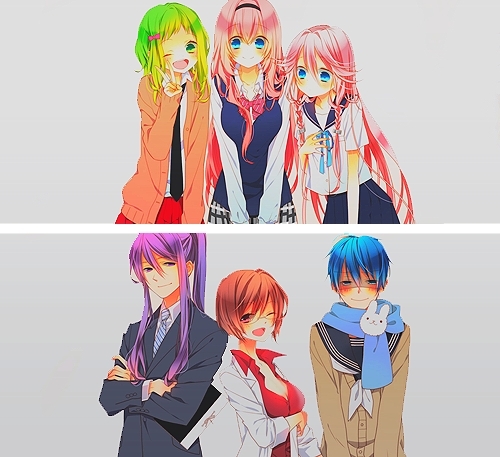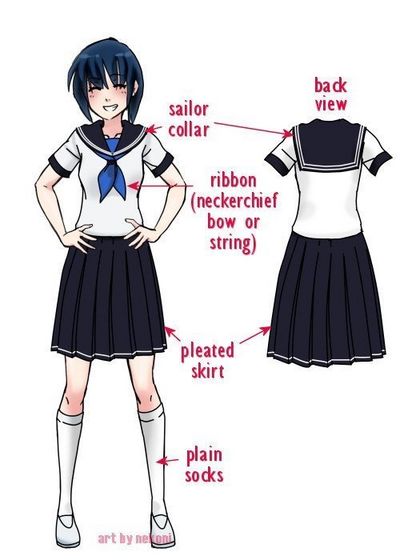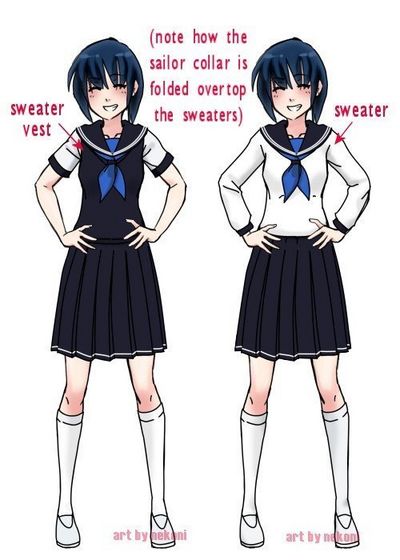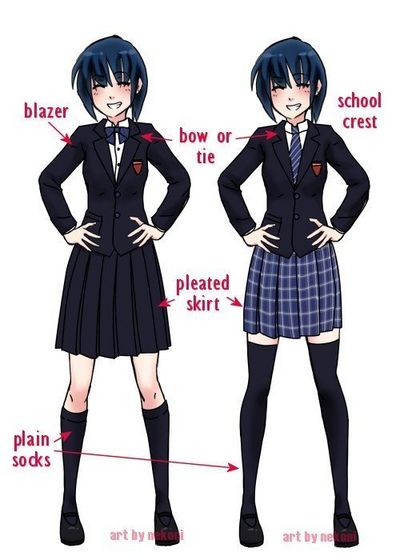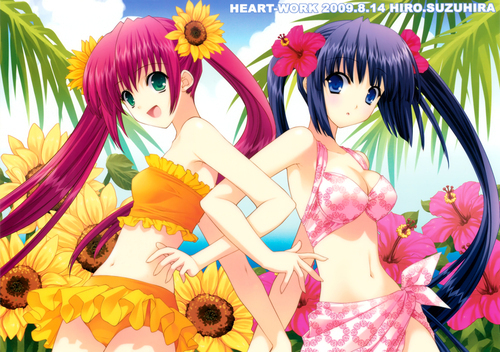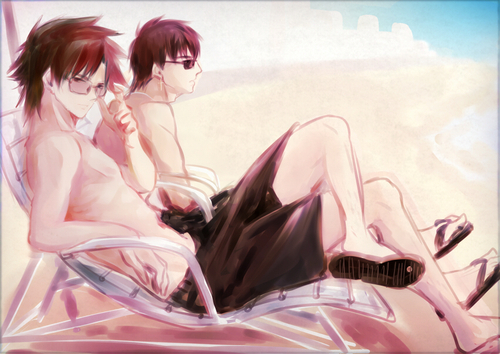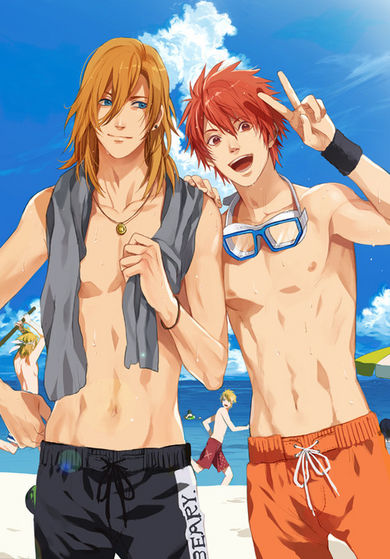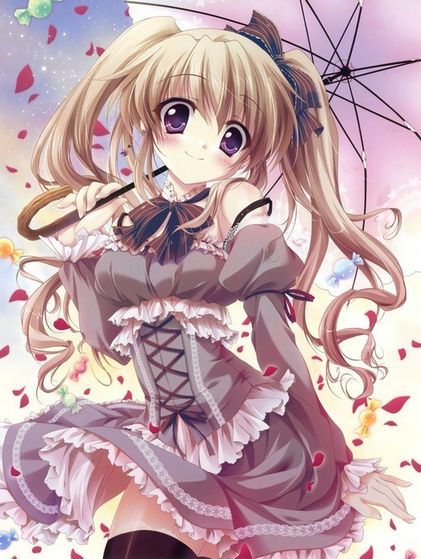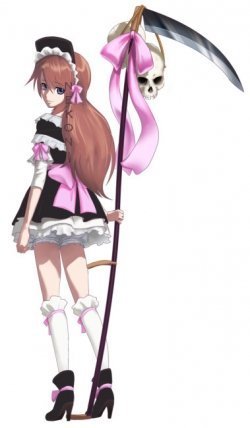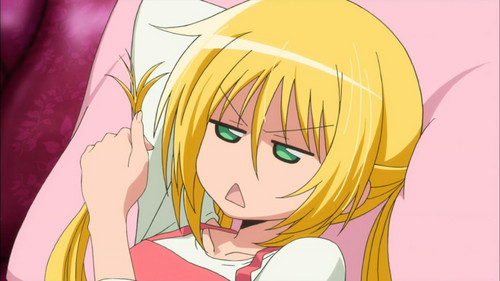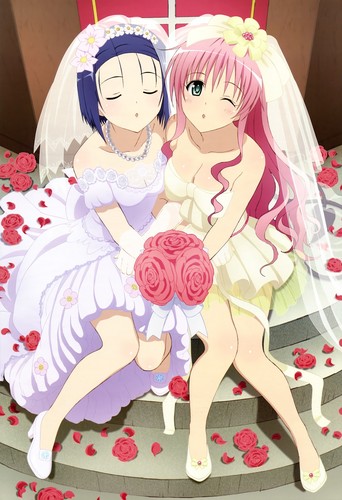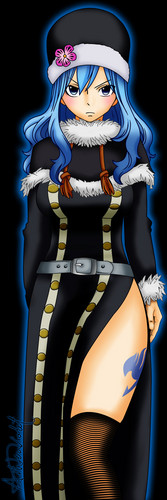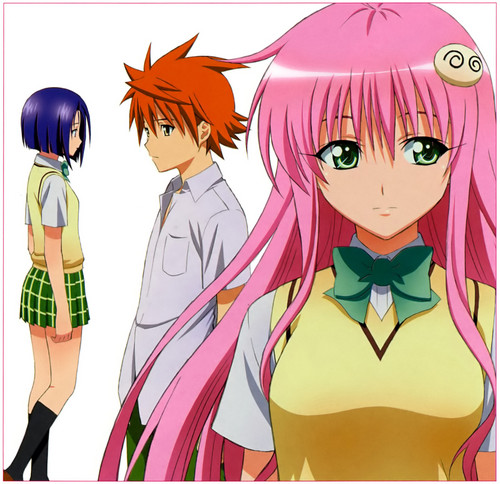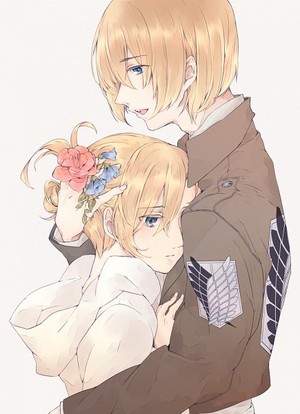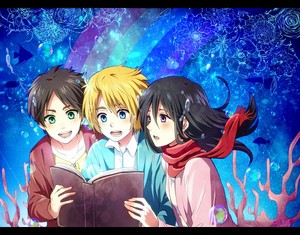Most often it's easy to understand ऐनीमे fashion, after all, mainstream fashion tends to be shared all around the world.
But on the odd occasion, when watching your प्रिय shows या पढ़ना your प्रिय manga, you'll find something that doesn't quite make sense.
Perhaps you've come across a teenage girl with apparently demure tastes, but an iron-fisted approach to life?
या maybe a man who looks like a पार करना, क्रॉस between a biker and an Elvis impersonator?
Curious as to what it all means या where it comes from? Read on!
School Uniform
So many ऐनीमे are set in highschools that it's impossible to ignore this one! If आप live in a country with the same system of uniforms (england, australia, china) japanese school uniforms will make some sense. If आप come from a country where school uniform is rare या inexistant, the whole concept in itself is going to be foreign to you.
So the first thing आप need to know, is uniforms are used to promiote social equality. Rich kids can't दिखाना off fashion, and poor kids can't be picked on for being poor- so you'll only see a little rich-kid vs poor-kid drama in ऐनीमे compared to what you'd see in US teen drama.
The सेकंड thing is that, uniforms are very difficult to express या be fashionable with, so differences tend to focus on how items are worn, या what accesories they're worn with.
The uniforms I'll describe are worn द्वारा middle and highschool students. Younger children in जापान do sometimes wear uniform, but it's very varied. They do all wear brightly colored (usually yellow) hats when going to and from school, and boys usually wear black backpacks, while girls wear red backpacks. Even younger children in care-groups also wear colored hats, as a sort of uniform.
Sailor Uniform
The sailor uniform is based on British Naval uniforms (thus the 'sailor'). Sailor uniforms are लोकप्रिय uniforms throughout East Asia. In Japan, they are used specifically for girls, and are the traditional school uniform that is most associated with Japan.
Sailor uniforms in real life are usually dark blue, black, या white, with blue, black, white या red stripes on the collar, and sometimes on the sleeves या skirt. In ऐनीमे they vary through many different रंग and extravagant designs. 1, 2 या 3 stripes are all popular.
Sailor uniforms are less लोकप्रिय in real life. They used to be worn द्वारा all ages, but now are mostly worn द्वारा middle-school students.
In summer, girls usually wear a कमीज, शर्ट with no sweater.
The little necktie that goes around the neck of the कमीज, शर्ट is simply called a 'ribbon' in Japan. It can be a simple tie, या और stringy, या tied in a bow. A girl might give her necktie to a boy she likes.
Girls wearing sailor uniform have the option of extra sweaters. The long-sleeved sweater is for winter.
Girl's Western Style Uniform
Western style uniforms in ऐनीमे used to दिखाना that a student was from an expensive school, but as sailor uniforms are falling out of fashion amongst high schools in real life, these western style uniforms are becoming और popular, especially amongst older high school students.
The blazer is the चोटी, शीर्ष layer for a schoolgirl's outfit. It is the smartest part of the uniform, so when all the characters in ऐनीमे are wearing their blazers, buttoned up, it probably means it's a formal occasion, (that, या they're just very clean, neat people!)
The संपूर्ण, कुल मिलाकर डिज़ाइन is similar to an adult suit, with a white dress कमीज, शर्ट and either a plain स्कर्ट या tartan skirt. Uniforms for girls include may a bow, string bow, या a necktie. A sweater may be worn in colder weather, या द्वारा shyer ऐनीमे characters.
Boy's Western Style Uniform
A boy's western uniform is not much different to a gakuran. He wears a blazer as his jacket, and a tie. His school crest goes on the blazer pocket, and western uniforms vary a lot और in color than gakuran so the different school's uniforms are much और easily recognised.
It is quite लोकप्रिय to have a pair of pants in a different color to the blazer, such as tan या grey.
Girl's Swim Wear
In ऐनीमे you'll often see a girl wear her स्विमिंग सूट to the beach. The स्विमिंग सूट rule for girls are like those who are under teenage साल should bathing सूट्स and those who are teen या above teen (if they wants) wears a bikini.
Boy's Swim Wear
Boys and girls have very different swim suits. Guys wear a short when they go out in the beach. Some guys wear a loose shirts to go with the shorts.
Shoes
Shoes are the least strict part of a japanese school uniform.
The japanese do not wear shoes indoors, so schools all have special indoors shoes, which are white, soft, and very cheap. These shoes sometimes have a band of color on them, to दिखाना which class the wearer is in.
The most formal shoes that can be worn are black, leather, shoes- but white sneakers are incredibly popular, and allowed.
ऐनीमे characters also wear knee-high boots, nike shoes and कॉनवर्स shoes in all other casual days.
Crazy for Cute!
जापान loves cute! It is part of Japan's national identity, and there is a lot of focus on cute styles and brands. This is because childhood in जापान is very, very treasured, as it is a time in life where japanese people have the most free time. Adults often like to dress slightly cute and wear cute accesories, as it is an easy way to behave childishly that is not rebelious. This still happens in other countries- so you'll find it easy to understand, but it is और common in Japan.
Skirts and Dresses
In the west, for hundreds of years, girls and women were expected to wear dresses, and pants were for men. Because of this, a lot of western women feel dresses are not a nice thing to wear.
This is not the same in Japan. There is no negative thoughts about skirts and dresses, as they haven't had them for long, they aren't consiered 'demure' या 'old fashioned', they're just look very cute on girl's! So, they're worn a lot और frequently in जापान than in the west, including in anime. Japanese girls will even wear them in cold weather, because it is good character not to complain about the cold (those poor girls!)
Lolita Fashion
Lolita fashion is easily recognized द्वारा being a short dress with a distinctive bell-like shape.
Long examples exist, as do less puffy versions, but short and puffy is the norm (especially in anime).
The संपूर्ण, कुल मिलाकर appearance of most wearers of Lolita fashion is doll-like, and some of the girls who dress in this fashion will very often aim directly for the appearance for a चीनी मिटटी, चीनी मिट्टी के बरतन doll, including hair accessories, hats and parasols.
There are many sub genres, as Lolita compliments almost every other style. The most commonly seen in ऐनीमे are 'Classic', 'Sweet', 'Princess' and 'Gothic' Lolita.
There's no real meaning for Lolita fasion in real life. Lolitas don't do certain jobs, या act a certain way. It's just a fashion, and that is reflected in most anime.
Maid Dresses
The Japanese version of the 'French Maid' outfit. The shape of the Japanese version tends to follow the shape of a Lolita dress, but will often have a shorter skirt.
The maid outfit is often the uniform of themed 'maid cafés', which are very लोकप्रिय with male ऐनीमे या game fans.
The maid outfit is a common form of fan-service in anime, and it can be worn द्वारा a maid café employee, an 'authentic' maid, या just as a costume. It's also a लोकप्रिय form of punishment for characters who hate dresses!
Gang Fashions
Bosozoku and Yanki:
These are biker gangs that are no longer in fashion, but are quite frequently seen in ऐनीमे and manga.
Bosozoku are characterised as wearing jumpsuits, military overcoats या leather jackets, often worn open with bandages wrapped around their torsos. They tend to have a quite biker-ish look about them.
They're most easily recognised द्वारा the kanji या rising sun designs (similar to the Japanese flag) on their coats या shirts and their often extravagant hairstyles, which vary from a slight Elvis-quiffs to punch-perms (see 'hair', below)
They also wear long boots, and ride modified bikes या scooters. There are females members, and a female version called Yanki who share a similar fashion.
They carry non-classified weapons, such as metal pipes या 'boken' (especially strong wooden swords that are used for martial arts training). In ऐनीमे they are most often shown as villains, but sometimes will be a cool, tough protagonist; and it is not uncommon for a protagonist to temporarily शामिल होइए this sort of gang.
Today, bosozoku are a lot rarer and less extravagent, but they are still लोकप्रिय in their original form as villains in anime.
Tattoos
टैटू have an entirely different meaning in Japan, because टैटू in जापान are very deeply associated with Yakuza, and were actually outlawed for nearly 100 years up until 1948.
An ऐनीमे character with a tattoo, whether that character is a foreigner या not, is likely to at least have a tough personality या some conflict with society.
If the tattoo covers a lot of the body, it's even और likely to be an actual yakuza member.
In anime, tatoos will sometimes appear या change magically, and often imply some sort of curse या evil possession.
Characters with टैटू may simply be a tough nice guy, या a nasty villain.
But on the odd occasion, when watching your प्रिय shows या पढ़ना your प्रिय manga, you'll find something that doesn't quite make sense.
Perhaps you've come across a teenage girl with apparently demure tastes, but an iron-fisted approach to life?
या maybe a man who looks like a पार करना, क्रॉस between a biker and an Elvis impersonator?
Curious as to what it all means या where it comes from? Read on!
School Uniform
So many ऐनीमे are set in highschools that it's impossible to ignore this one! If आप live in a country with the same system of uniforms (england, australia, china) japanese school uniforms will make some sense. If आप come from a country where school uniform is rare या inexistant, the whole concept in itself is going to be foreign to you.
So the first thing आप need to know, is uniforms are used to promiote social equality. Rich kids can't दिखाना off fashion, and poor kids can't be picked on for being poor- so you'll only see a little rich-kid vs poor-kid drama in ऐनीमे compared to what you'd see in US teen drama.
The सेकंड thing is that, uniforms are very difficult to express या be fashionable with, so differences tend to focus on how items are worn, या what accesories they're worn with.
The uniforms I'll describe are worn द्वारा middle and highschool students. Younger children in जापान do sometimes wear uniform, but it's very varied. They do all wear brightly colored (usually yellow) hats when going to and from school, and boys usually wear black backpacks, while girls wear red backpacks. Even younger children in care-groups also wear colored hats, as a sort of uniform.
Sailor Uniform
The sailor uniform is based on British Naval uniforms (thus the 'sailor'). Sailor uniforms are लोकप्रिय uniforms throughout East Asia. In Japan, they are used specifically for girls, and are the traditional school uniform that is most associated with Japan.
Sailor uniforms in real life are usually dark blue, black, या white, with blue, black, white या red stripes on the collar, and sometimes on the sleeves या skirt. In ऐनीमे they vary through many different रंग and extravagant designs. 1, 2 या 3 stripes are all popular.
Sailor uniforms are less लोकप्रिय in real life. They used to be worn द्वारा all ages, but now are mostly worn द्वारा middle-school students.
In summer, girls usually wear a कमीज, शर्ट with no sweater.
The little necktie that goes around the neck of the कमीज, शर्ट is simply called a 'ribbon' in Japan. It can be a simple tie, या और stringy, या tied in a bow. A girl might give her necktie to a boy she likes.
Girls wearing sailor uniform have the option of extra sweaters. The long-sleeved sweater is for winter.
Girl's Western Style Uniform
Western style uniforms in ऐनीमे used to दिखाना that a student was from an expensive school, but as sailor uniforms are falling out of fashion amongst high schools in real life, these western style uniforms are becoming और popular, especially amongst older high school students.
The blazer is the चोटी, शीर्ष layer for a schoolgirl's outfit. It is the smartest part of the uniform, so when all the characters in ऐनीमे are wearing their blazers, buttoned up, it probably means it's a formal occasion, (that, या they're just very clean, neat people!)
The संपूर्ण, कुल मिलाकर डिज़ाइन is similar to an adult suit, with a white dress कमीज, शर्ट and either a plain स्कर्ट या tartan skirt. Uniforms for girls include may a bow, string bow, या a necktie. A sweater may be worn in colder weather, या द्वारा shyer ऐनीमे characters.
Boy's Western Style Uniform
A boy's western uniform is not much different to a gakuran. He wears a blazer as his jacket, and a tie. His school crest goes on the blazer pocket, and western uniforms vary a lot और in color than gakuran so the different school's uniforms are much और easily recognised.
It is quite लोकप्रिय to have a pair of pants in a different color to the blazer, such as tan या grey.
Girl's Swim Wear
In ऐनीमे you'll often see a girl wear her स्विमिंग सूट to the beach. The स्विमिंग सूट rule for girls are like those who are under teenage साल should bathing सूट्स and those who are teen या above teen (if they wants) wears a bikini.
Boy's Swim Wear
Boys and girls have very different swim suits. Guys wear a short when they go out in the beach. Some guys wear a loose shirts to go with the shorts.
Shoes
Shoes are the least strict part of a japanese school uniform.
The japanese do not wear shoes indoors, so schools all have special indoors shoes, which are white, soft, and very cheap. These shoes sometimes have a band of color on them, to दिखाना which class the wearer is in.
The most formal shoes that can be worn are black, leather, shoes- but white sneakers are incredibly popular, and allowed.
ऐनीमे characters also wear knee-high boots, nike shoes and कॉनवर्स shoes in all other casual days.
Crazy for Cute!
जापान loves cute! It is part of Japan's national identity, and there is a lot of focus on cute styles and brands. This is because childhood in जापान is very, very treasured, as it is a time in life where japanese people have the most free time. Adults often like to dress slightly cute and wear cute accesories, as it is an easy way to behave childishly that is not rebelious. This still happens in other countries- so you'll find it easy to understand, but it is और common in Japan.
Skirts and Dresses
In the west, for hundreds of years, girls and women were expected to wear dresses, and pants were for men. Because of this, a lot of western women feel dresses are not a nice thing to wear.
This is not the same in Japan. There is no negative thoughts about skirts and dresses, as they haven't had them for long, they aren't consiered 'demure' या 'old fashioned', they're just look very cute on girl's! So, they're worn a lot और frequently in जापान than in the west, including in anime. Japanese girls will even wear them in cold weather, because it is good character not to complain about the cold (those poor girls!)
Lolita Fashion
Lolita fashion is easily recognized द्वारा being a short dress with a distinctive bell-like shape.
Long examples exist, as do less puffy versions, but short and puffy is the norm (especially in anime).
The संपूर्ण, कुल मिलाकर appearance of most wearers of Lolita fashion is doll-like, and some of the girls who dress in this fashion will very often aim directly for the appearance for a चीनी मिटटी, चीनी मिट्टी के बरतन doll, including hair accessories, hats and parasols.
There are many sub genres, as Lolita compliments almost every other style. The most commonly seen in ऐनीमे are 'Classic', 'Sweet', 'Princess' and 'Gothic' Lolita.
There's no real meaning for Lolita fasion in real life. Lolitas don't do certain jobs, या act a certain way. It's just a fashion, and that is reflected in most anime.
Maid Dresses
The Japanese version of the 'French Maid' outfit. The shape of the Japanese version tends to follow the shape of a Lolita dress, but will often have a shorter skirt.
The maid outfit is often the uniform of themed 'maid cafés', which are very लोकप्रिय with male ऐनीमे या game fans.
The maid outfit is a common form of fan-service in anime, and it can be worn द्वारा a maid café employee, an 'authentic' maid, या just as a costume. It's also a लोकप्रिय form of punishment for characters who hate dresses!
Gang Fashions
Bosozoku and Yanki:
These are biker gangs that are no longer in fashion, but are quite frequently seen in ऐनीमे and manga.
Bosozoku are characterised as wearing jumpsuits, military overcoats या leather jackets, often worn open with bandages wrapped around their torsos. They tend to have a quite biker-ish look about them.
They're most easily recognised द्वारा the kanji या rising sun designs (similar to the Japanese flag) on their coats या shirts and their often extravagant hairstyles, which vary from a slight Elvis-quiffs to punch-perms (see 'hair', below)
They also wear long boots, and ride modified bikes या scooters. There are females members, and a female version called Yanki who share a similar fashion.
They carry non-classified weapons, such as metal pipes या 'boken' (especially strong wooden swords that are used for martial arts training). In ऐनीमे they are most often shown as villains, but sometimes will be a cool, tough protagonist; and it is not uncommon for a protagonist to temporarily शामिल होइए this sort of gang.
Today, bosozoku are a lot rarer and less extravagent, but they are still लोकप्रिय in their original form as villains in anime.
Tattoos
टैटू have an entirely different meaning in Japan, because टैटू in जापान are very deeply associated with Yakuza, and were actually outlawed for nearly 100 years up until 1948.
An ऐनीमे character with a tattoo, whether that character is a foreigner या not, is likely to at least have a tough personality या some conflict with society.
If the tattoo covers a lot of the body, it's even और likely to be an actual yakuza member.
In anime, tatoos will sometimes appear या change magically, and often imply some sort of curse या evil possession.
Characters with टैटू may simply be a tough nice guy, या a nasty villain.


